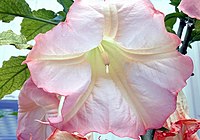
Photo from wikipedia
Abstract Nolana comprises 89 species almost entirely restricted to the Atacama and Peruvian deserts. These species are adapted to the arid lomas environment of northern Chile and southern Peru, where… Click to show full abstract
Abstract Nolana comprises 89 species almost entirely restricted to the Atacama and Peruvian deserts. These species are adapted to the arid lomas environment of northern Chile and southern Peru, where they depend on marine fog locally known as garúa or camanchaca for their development. Recent molecular phylogenetic studies provide support for the placement of Nolana in the Solanaceae rather than Nolanaceae. Additionally, a sister relationship with the tribe Lycieae has been suggested. The pollen morphology of 111 species from 18 genera of southern South American Solanaceae was investigated under light and scanning electron microscopes in order to establish the palynological affinities of Nolana within the Solanaceae and to investigate if pollen morphology is congruent with the phylogenetic relationships and former taxonomic classification of the species of Nolana. The following genera were studied: Nolana, Cestrum, Combera, Dunalia, Fabiana, Jaborosa, Latua, Lycium (incl. Grabowskia, Phrodus), Nicandra, Nicotiana, Nierenbergia, Petunia, Physalis, Reyesia, Salpiglossis, Schizanthus, Solanum and Vestia. Two pollen types that differ in exine structure were distinguished within Nolana; these pollen types are congruent with recent phylogenetic studies, thus, we propose to reinstate Nolana sect. Sorema.
Journal Title: Grana
Year Published: 2018
Link to full text (if available)
Share on Social Media: Sign Up to like & get
recommendations!